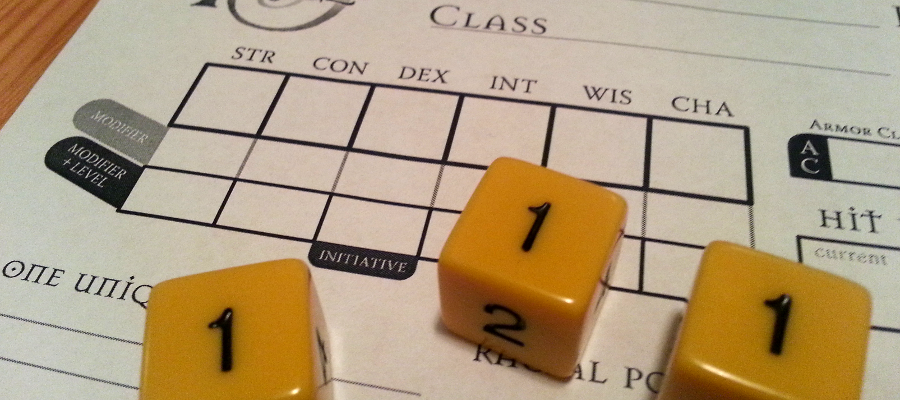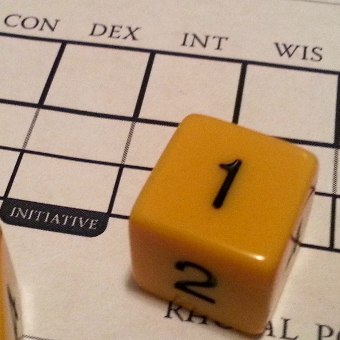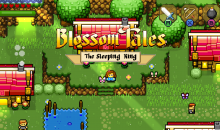Rolling D&D Stats is Bad For You, a Reprisal

I’m starting a 13th Age campaign with my group (which includes a few Dorkadia folks) and I couldn’t be more excited. We just finished a group character creation session this past Thursday and it inspired me to revisit an idea that I’ve written about before: generating attributes for Dungeons & Dragons games. It also doesn’t hurt to recycle content when I’ve been busy with New Year merry-making and planning for the new campaign.
13th Age’s character creation system knows what it’s doing; it will create a D&D character that is both loaded with interesting stories/conflicts and ready to slay monsters in dungeons. This is why I’m confused that it introduces a classic die rolling system to generate the 13th Age character attributes before it offers up a point buy system. There only warning in the book about the possibility that players may roll poorly and not like it. But that’s not actually the problem that d6s cause when generating D&D stats in modern iterations of the game. I wrote about rolling-vs-point-buy generation when I started a Pathfinder game last year. The random generation of stats using a bell curve creates bland characters that undermine the mechanical niche protection so crucial to modern editions of D&D, 13th Age included. It’s bad for you, your character, and your game.
Here’s what I had to say about it a year ago, with my added notes in italics:
Rolling Stats is Boring
I’m on the cusp of creating a new Pathfinder character and our DM has given us a choice when generating our attributes. We can choose either:
- 20 point buy: We spend a pool of 20 points to purchase our attributes, as per the core Pathfinder rules. To gauge power level, a pool of 20 points can create the attribute array of 16, 14, 14, 12, 10, 8. [The 13th Age system point buy system is functionally the same.]
- Roll: Generate 6 values by rolling 4d6, reroll any 1s, drop the lowest die, then add up the remaining three dice. We then assign the values to whatever attribute we want. “4d6R-L” generates stats around 13.25, give or take. [13th Age doesn’t reroll 1s, so it has an average that’s around 12, but that doesn’t change the argument.]
Some members of our group have defended rolling dice, saying that point-buy systems create cookie-cutter characters that all have the same statistics. I actually believe the opposite: rolling dice creates homogenized characters that are less interesting than those generated by a point buy system. Here’s why: Point buy systems guarantee characters with both strengths and weaknesses.
Sure, same-y arrays are naturally going to come out of point buy systems, but they only feel same-y when you write the numbers in order on paper. A whole party could buy the standard 16, 14, 14, 12, 10, 8, which in theory should create a same feeling party, but that ensures that your character can do some shit and can’t do some shit. This actually creates niches that the other characters need to cover; built in focuses and forced deficits. Those 10′s and 8 are going somewhere.
Rolling dice with an average roll of 13.25 creates attributes that are more inclined to be like each other: 15, 14, 14, 13, 13, 12 is a reasonable spread for rolling dice. Even though it’s technically “stronger” than the 20 point buy array, it’s boring [without those strengths and weaknesses]! You’d never get something that boring with a point buy. (Unless of course someone chooses to be boring, but boringness born of choice rather than statistics is different.)
The game play of modern D&D revolves around groups of specialists aiding each other to accomplish heroic goals. Rolling dice can sabotage this in a big way.
So for God’s sake, guys, stop hating on point buy systems. It reinforces the very basic ideas behind D&D gameplay and it creates fun choices for players at character creation without the risk of statistical anomalies. While it’s true that in D&D 3.5 and Pathfinder some classes are less viable with point buy systems (Paladins just need higher stats than a wizard, and that’s that) that’s a fault with the system, not the mode of generation. [13th Age doesn’t have this problem. Most classes use two stats for their combat abilities, there is no Paladin that needs Strength, Wisdom, Charisma, and a touch of Dexterity.]
I will be choosing to buy my stats, for the record.
[*Full disclosure: I couldn’t resist revising a few things to make my point more clearly. Not that any one would notice.]
Next Time, 13th Age
I skirted by this week recycling material, but when I return to Dorkadia on January 22nd I’ll be reporting on our first session of 13th Age. Hopefully it offers some D&D monster-fighting with a strong story-game spirit. If you haven’t checked out the game’s website, do yourself a favor and take a moment to scope it out.







Here is another points buy system that you can use.
All abilities start at a value of 8. The highest an ability is, the more it costs to increase it of a single point. In example, setting an ability to 14 costs 6 (14-8), but then, going to 16 costs 4 more (2 buy points per ability score point).
If you need more informations about this system, or help with abilities calcul, you can use the calculator on http://dndhelp.info
What you are failing to address is that not everyone has the same weaknesses. Some people are just better. With the point buy model you used every melee fighter generated will look the same,str 16 con 14 int 10 cha 8. I fail to see how that makes amore interesting character. W ith rolling yes some characters are below average pcs,I have had a character with nothing but 10’s and 11’s but it was more interesting for me to turn an essentially normal joeinto a hero or villian. On the opposite note I have had a character with straight 18’s. That character was interesting because he didnt have the general weakness of his class and it made more sense to me for him to multiclass, because if you are naturally good at lots of stuff which is reflected by stats why not train to be better via classes? So to me dice rolling yields more interesting characters than, as your friends put it cookie cutter point buy. That’s just my opinion.
With a point buy system you are skipping over a important aspect that dice-rolling gives, certain weaknesses. How fun is it if everyone has a minimal of 8 in every stat making them completely “average joe”. Dice rolling is more sporadic and comes up with wilder results. I have had a character that was str5 con10 int18 wis16 char13 dex11 and it really decided what kind of guy my character is, a feeble wizard that can catch you on fire but can’t take a hit. With those generic stats made by point allocation it’s basically saying that your guy has no serious weaknesses or strength to play off of when role-playing.
Besides waiting and hoping that the luck of the dice is on your side is more exiting than just saying “oh I want to be a warrior, put a str of 18 and everything else I’ll just average” besides with a die roll you have to be adventurous and try out different classes and maybe you’ll enjoy it. You played a warrior in the last campaign but rolled a 17 in wisdom? Great now try out what clerics can d.That’s part of the fun in DnD, exploring different options and coming up with someway to make the game better for everyone. Who knows, you may like being a cleric better than a warrior.
With rolling, your character concept comes after you roll your attributes. With point buy, your character concept comes before you start character creation.
Neither is inherently better than the other.
Exactly. This seems to be so hard for some people to understand that they write articles about how much the other method of generation supposedly sucks. I let my players choose and don’t become a bullying douche when they choose point buy. It’s up to them, no one else. Neither method is better and never will be.